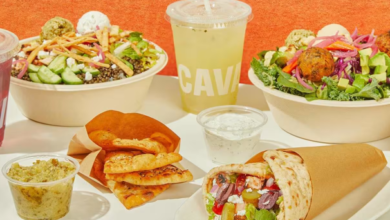Wondering How to Save on Groceries? Vegetarian Meals Can Help


If you’ve been considering switching to a vegetarian diet, there’s no better time to center plants on your plate.
As the rising costs of foods like red meat and dairy hit home, embracing that vegetarian or vegan lifestyle is increasingly attractive.
Since 2021, consumers have been absorbing prices ranging from 10 to 15% higher on grocery staples like eggs and chicken, according to the federal food price outlook report.
As grocery costs balloon, some people question whether eating vegetarian can actually save money. Isn’t filling your plate with organic, plant-based foods from trendy markets equally expensive?
Going vegetarian can be $10 smoothies and pricey natural food stores, but it doesn’t have to be. The reality is reaching for veggies to fill your grocery cart benefits your health and your wallet. You can even save money with a mostly vegetarian diet.
Here are 10 ways going vegetarian can help you save money.
- Pass on the meat substitutes
- Frozen veggies are your friend
- Don’t ditch the bulk warehouse membership
- Build buying local into your budget
- Choose generic and store brands
- Get chopping for cheap
- Look for recipes with overlapping ingredients
- Shop the regular grocery store
- Start working on your green thumb
- When in doubt, do a grain, a green and a bean
But first, let’s talk about how much you could save.
How Much Money Can You Save Going Vegetarian or Vegan?
The myth that vegetarian diets featuring lots of fresh fruits and vegetables aren’t affordable or accessible has persisted for years.
However, a 2021 study from Oxford University indicates vegetarian, vegan and even flexitarian diets are more affordable than being an omnivore. (An unrelated 2015 U.S. study found that vegetarians tend to save an average of $750 a year on groceries over meat-eaters.)
Oxford researchers analyzed the cost of seven sustainable diets in 150 countries — including the U.S., the UK, Australia, and Western Europe — and concluded that any diet with little to no meat saved money.
The biggest savings come from vegetarian and vegan diets that rely on legumes and whole grains. Researchers didn’t examine how buying costly processed meat substitutes could affect savings.
- Eating vegan could slash food costs by up to 33%.
- Going vegetarian saved nearly as much as a vegan diet.
- You could save about 14% by eating a flexitarian diet with lower amounts of dairy and meat. A flexitarian diet includes vegetarian meals, though you still eat meat occasionally.
In comparison, those who eat fish and meat pay nearly 10% more for groceries. Pescatarians, who are vegetarian except for seafood, spend up to 2% more on food, according to the study.
“When scientists like me advocate for healthy and environmentally-friendly eating, it’s often said we’re sitting in our ivory towers promoting something financially out of reach for most people. This study shows it’s quite the opposite. These diets could be better for your bank balance as well as for your health and … the planet,” said Dr. Marco Springmann, study author and researcher with the Oxford Martin Programme on the Future of Food.
How Much Does Eating Meat Cost You?
Even if you find ways to save on meat, that chicken breast is still the most expensive item on your plate. But won’t you miss it?
Not necessarily. There are lots of meals — lasagna, curry, salads, soups — where meat isn’t the focus. Take the burrito bowl: a mix of meat, rice, beans and other veggies for less than $2.50 a serving.
That same recipe without meat comes in at $1.50 a serving. An even more basic vegetarian burrito bowl could even be as cheap as $1.17 per serving.
Saving a few dollars per meal on a meat-free diet may not seem like much, but those dollars do add up.
10 Ways Eating Vegetarian Can Save You Money on Groceries
Regardless of who you are — vegan, vegetarian, flexitarian or someone who eats meat — these tips will help you avoid common grocery shopping pitfalls and sweep up savings on veggies
1. Pass on the Meat Substitutes
Pre-packaged chicken substitutes or fancy veggie burgers are a quick fix, but they add a lot of extra expense to your grocery bill. (You can make that veggie burger yourself for less than $1.)
Instead, look to buy a variety of protein sources to flesh out a plant-based diet, such as beans and whole grains.
Buying in bulk can offset some of the costs of the plant foods that are a cornerstone of a healthy vegetarian diet. Consider too that sometimes adding a protein is as simple — and cheap — as opening a can of black beans.
2. Frozen Fruits and Veggies Are Your Friend
Not only are veggies cheaper and contribute to weight loss, but fruits and vegetables frozen at the height of freshness lock in nutritional value for you to enjoy later.
And opting for a vegan or vegetarian diet doesn’t mean you have to buy organic. Experts advise buying organic only for items you consume daily or that are higher in pesticides, so clear space in your freezer and shop those produce specials with a clear conscience.
3. Don’t Ditch the Bulk Warehouse Membership
Now that you’re not buying 10 pounds of pork loin, you might consider giving up that Costco membership. But bulk warehouse clubs still offer great ways to indulge that vegetarian lifestyle by stocking up on cases of beans, whole grains and even pre-packaged items for quick meals during busy weeknights.
4. Build Buying Local into Your Budget
It can take effort to buy local food, but the discounts — and satisfaction of supporting your community — are worth it.
Community Supported Agriculture (CSA) groups offer delivery or pickup of fresh, in-season fruits and vegetables in many areas across the country. You can use this USDA directory to find one near you.
Shopping at a nearby farmer’s market makes fresh food more accessible and affordable, too.
5. Choose Generic and Store Brands
Every shopper knows that buying generic brands cuts costs, but that can be especially true for vegetarian products dominated by niche labels and high-end products designed to appeal to foodies.
Some grocery stores compound this problem by stuffing “vegetarian” products into one aisle like they do ethnic foods. Skip the shelves stocked with expensive gluten-free, organic, non-GMO products and stick with basic generic or store brands.
6. Get Chopping for Cheap
Those pre-chopped bags of veggies are convenient, but save that added expense for that one night a week when the dinner rush is a grind. Instead, roll up your sleeves and get all your chopping down before you start cooking. You could even prep ahead for another recipe later in the week.
Need some help chopping, dicing and parsing your way through the produce section? Award-winning chef Amy Chaplin shows you how to tackle every vegetable.
7. Look for Recipes With Overlapping Ingredients
Variety is the spice of life, but it can also be expensive and cause a lot of food waste. Search for vegetarian dishes that leverage familiar foods and have overlapping ingredients.
If a vegetarian recipe has a costly specialty item, look for a cheaper alternative or skip it. Many vegan and vegetarian cookbooks contain a staples section that can help you stock up your pantry on plant-friendly basics.
8. Shop the Regular Grocery Store
Going vegetarian doesn’t have to mean scouring natural or health food stores for ingredients you can’t pronounce.
Today’s approach to delicious vegetarian dishes is simple and relies on familiar foods stocked on shelves at any grocery store.
9. Start Working on Your Green Thumb
A backyard the size of a postage stamp — or none — shouldn’t be a barrier to planting your victory garden. Today’s urban gardeners prove that you don’t need a huge plot of land or even an apartment balcony to get started.
Leverage small indoor or tiered planters to save on space and produce the more expensive items in a vegetarian diet, like herbs or tomatoes.
10. When in Doubt, Do a Grain, a Green and a Bean
There’s a simple formula for constructing meatless meal on the cheap. Popularized by Matt Frazier of No Meat Athlete, the strategy for becoming a vegetarian on a budget is called a grain, a green, and a bean.
Choose whole grains, whatever green leafy vegetables you have in the fridge and open a can of beans. It’s an easy formula for quick and satisfying meals without the fuss.
Start Small and Save Big by Going Vegetarian Sometimes
If going cold turkey on, well, turkey seems daunting, remember you don’t have to stop eating meat. You can save money just by eating meat and dairy products less often.
Say you spend $500 a month on groceries. Based on the 14% savings researchers found for flexitarian diets, you could lower your grocery bill by $70. That adds up to $840 over a year.
You can still eat eggs (like ovo vegetarians) or eat chicken and dairy products or fortified foods.
So work a meatless meal or two into your menu rotation and let that vegetarian diet go to work on your budget. Your wallet — and doctor — will thank you.
Kaz Weida is a senior writer for The Penny Hoarder.
Source link





